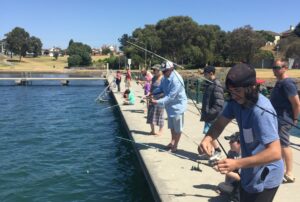
- Scientific Name
- Tandanus tandanus
- Size
- Commonly 45 centimetres, up to 90 centimetres
- Weight
- Around 2kg
General Description
Freshwater catfish are native to Australia and were once very popular with recreational anglers due being an excellent fish for the table.
Catfish have a unique appearance. They range from grey or brown in smaller fish with dark brown to black mottling and larger fish range from brown, olive-green, purplish or black with a whitish belly and underside of the head. They have an elongated and slender body with an eel-like, pointed tail and four pairs of barbels surrounding the mouth. Catfish can grow to 90 centimetres in length, however, they are commonly found around 45 centimetres and 2 kilograms.
Behaviour
Catfish prefer to inhibit slow flowing, still water in streams and lakes. Adult catfish are usually solitary and sedentary fish with limited movement throughout the river. They are opportunistic, bottom feeders and are most active during the night.
Where to Find
Permitted waters: Freshwater catfish can only be taken from waters within the Wimmera Basin. In the Wimmera Basin, freshwater catfish have a minimum legal size of 30cm and a bag limit of 2.
Restricted waters: The taking of catfish is prohibited in all other Victorian waters.
Fishing Rules
See note under Where to Find above. In the Wimmera Basin, freshwater catfish have a minimum legal size of 30cm and a bag limit of 2.
Threats and Management Issues
Over the years there has been a decline in the distribution and abundance of freshwater catfish. They were once widespread across eastern Australia, from coastal rivers in Queensland and New South Wales and throughout the inland Murray-Darling system. They are now classified as ‘endangered’ in Victoria. Contributing to the decline of catfish can include degraded habitat, barriers impacting their movement and competition with introduced species such as European carp.






